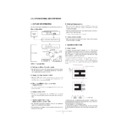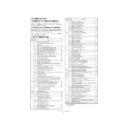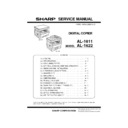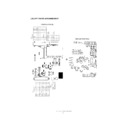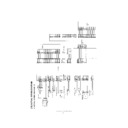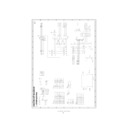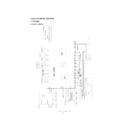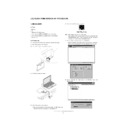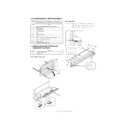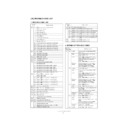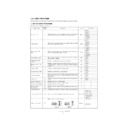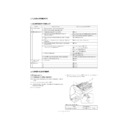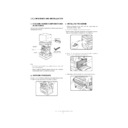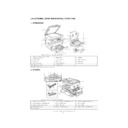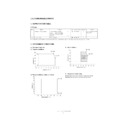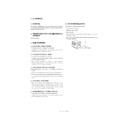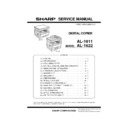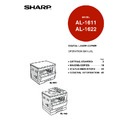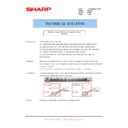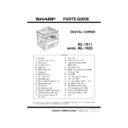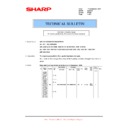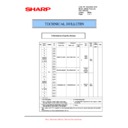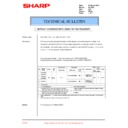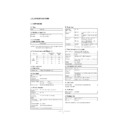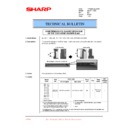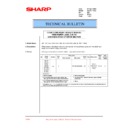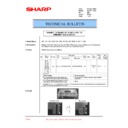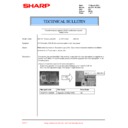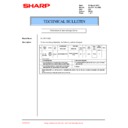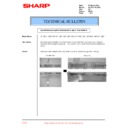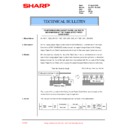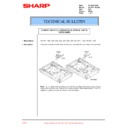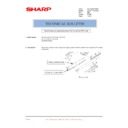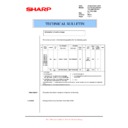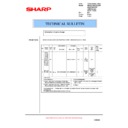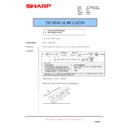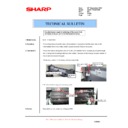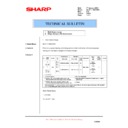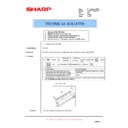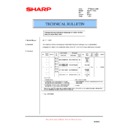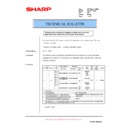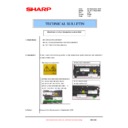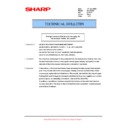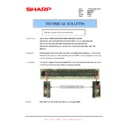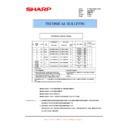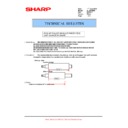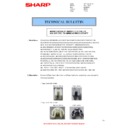Sharp AL-1622 (serv.man9) Service Manual ▷ View online
AL-1611/AL-1622
OPERATIONAL DESCRIPTIONS
6 – 2
B. Basic structure of scanner section
The light from the light source (Xenon lamp) is reflected by a document and passed through three mirrors and reduction lenses to the CCD element
(image sensor) where images are formed. This system is known as the reduction image sensor system. Photo energy on the CCD element is con-
verted into electrical signals (analog signals). (Photo-electric conversion). The output signals (analog signals) are converted into digital signals (A/D
conversion) and passed to the MCU (main control/image process section). The resolution at that time is 400dpi. The mirror unit in the scanner section
conversion) and passed to the MCU (main control/image process section). The resolution at that time is 400dpi. The mirror unit in the scanner section
is driven by the mirror motor. The MHPS is provided to detect the home position of the copy lamp unit.
3. PROCESS SECTION
A. Basic structure
1
Copy lamp (Xenon lamp)
Generate photo energy to scan documents.
2
Reflector (Converging plate)
Collects light emitted from the copy lamp and radiate the document.
3
No. 1 mirror
Refracts the reflection light from the document to No. 2 mirror.
4
No. 2 mirror
Refracts the reflection light from No. 1 mirror.
5
No. 3 mirror
Refracts the reflection light from No. 2 mirror.
6
Lens
Converges reflected light from the document to form images on the CCD element.
7
No. 2/3 mirror unit
Includes No. 2/3 mirror. Driven in synchronization with the copy lamp unit.
8
Copy lamp unit
Includes the copy lamp, the reflector, and No. 1 mirror. Driven in synchronization with No. 2/3
mirror unit by the mirror motor.
mirror unit by the mirror motor.
9
CCD PWB
Reflected light (image) formed on the CCD is converted into electrical signals (analog signals)
then into digital signals and sent to the MCU.
then into digital signals and sent to the MCU.
10
Mirror motor
Drives the copy lamp unit and No. 2/3 mirror unit according to the scanning speed.
11
MHPS (Mirror home position sensor)
Detects the home position of No. 2/3 mirror unit.
12
Reference white plate
Reference white sheet for scanning documents. The reference line of magnification ratio
adjustment during SIM is also drawn.
adjustment during SIM is also drawn.
13
OC glass
Glass table to put a document on it.
1
Main charger unit
Charges the OPC drum.
2
Cleaning blade
Collects waste toner on the OPC drum.
3
OPC drum
Images are formed by laser beams electri-
cally, and toner is attached to the image.
cally, and toner is attached to the image.
4
Transfer unit
Toner on the OPC drum is transferred to the
print paper by the potential difference.
print paper by the potential difference.
5
Resist roller
Makes synchronization between the paper
and the print image.
and the print image.
6
MG roller
Magnetic brush is formed by developer to
put toner on the OPC drum.
put toner on the OPC drum.
7
(Laser beam)
Forms images on the OPC drum.
AL-1611/AL-1622
OPERATIONAL DESCRIPTIONS
6 – 3
Operation cycle
B. Outline of print process
The printer section of this machine employs the laser print system
where print images are formed by the laser beams on the OPC drum.
where print images are formed by the laser beams on the OPC drum.
A high voltage (corona) is applied from the main charger to the OPC
drum to charge the OPC drum.
Laser beams are radiated to the charged OPC drum to form electrical
images on the OPC drum. (Exposure)
images on the OPC drum. (Exposure)
(At that time, the print image on the OPC drum cannot be seen: latent
electrostatic image)
By the potential difference between the unexposed area and the latent
electrostatic images, toner ia attracted only to the images. (Developing)
electrostatic images, toner ia attracted only to the images. (Developing)
(At that time, the print image formed by toner on the OPC drum can be
seen. Visible images)
The toner image on the OPC drum is transferred on the print paper by
the transfer corona (voltage).
the transfer corona (voltage).
After that, the print paper with the toner image on it is subject to heat
and pressure in the fusing section to fuse the image on the paper.
This machine employs the following organic photoconductor (OPC)
drum.
drum.
C. Actual print process
(1) Charging
A high voltage is applied to the main charger, and negative charges are
discharged to the OPC drum. A screen grid is provided between the
main charger and the OPC drum, and negative charges are uniformly
main charger and the OPC drum, and negative charges are uniformly
charged on the OPC drum surface.
Positive charges are attracted by the negative electrode on the OPC
drum surface and excited in the aluminum layer in the OPC drum.
Paper exit roller
Paper exit
Heat roller
Fusing
Cleaning blade
Waste toner box
Separation
Cleaning
Separation charger
High voltage power
High voltage power
Main charger
Charging
Transfer
Transfer
Transfer charger
High voltage power
Laser scanning unit
Laser beam
Exposure
Developing
Synchronization
with drum
with drum
Resist roller
High voltage
power
power
Developing unit
Toner hopper
Developer
Toner
Cassette paper
feed
feed
Manual paper
feed
feed
(20microns thick)
Aluminium drum
Pigment layer (0.2
to 0.3 microns thick)
to 0.3 microns thick)
An OPC drum is used for the photoconductor.
(Structure of the OPC drum layers)
(Structure of the OPC drum layers)
OPC layer
DC5.5KV
(-525V/-400V)
AL-1611/AL-1622
OPERATIONAL DESCRIPTIONS
6 – 4
(2) Exposure
A Laser beam is generated from the semiconductor laser and controlled
by the print pattern signal. The laser writes onto the OPC drum surface
by the print pattern signal. The laser writes onto the OPC drum surface
through the polygon mirrors and lens. The resistance of the OPC layer
decreases for an area exposed by the laser beam (corresponding to the
print pattern signal). The beam neutralizes the negative charge. An
print pattern signal). The beam neutralizes the negative charge. An
electrostatic latent image is formed on the drum surface.
(3) Developing (DC bias)
A bias potential is applied to the MG roller in the two component mag-
netic brush developing method, and the toner is charged negative
netic brush developing method, and the toner is charged negative
through friction with the carrier. Non-image area of the drum surface
charged with negative potential repel the toner, whereas the laser
exposed portions where no negative charges exist, attract the toner. As
exposed portions where no negative charges exist, attract the toner. As
a result, a visible image appears on the drum surface.
Toner is attracted over the shadowed area because of the developing
bias.
bias.
(4) Transfer
The visible image on the drum surface is transferred onto the print
paper by applying a positive charge from the transfer corona to the
paper by applying a positive charge from the transfer corona to the
backside of the print paper.
(5) Separation
Since the print paper is charged positively by the transfer corona, it is
discharged by the separation corona. The separation corona is con-
nected to ground.
nected to ground.
(6) Cleaning
Toner remaining on the drum is removed and collected by the cleaning
blade. It is transported to the waste toner collecting section in the clean-
blade. It is transported to the waste toner collecting section in the clean-
ing unit by the waste toner transport roller.
OPC layer
Pigment
layer
layer
Aluminum
OPC layer
Pigment
layer
layer
Aluminum
layer
layer
Drum surface charge
sfter the exposure
sfter the exposure
Non-image area
Image area
Semiconductor laser
Exposure
(semiconductor laser)
(semiconductor laser)
layer
S
N
N
MG roller
DC
-400v
-400v
-8V
: Carrier (Magnetized particle)
: Toner (Charge negative by friction)
(N) (S) : Pemanent magnet
(provided in three locations)
(provided in three locations)
-600
0
Toner attract
potential
potential
D
ru
m
s
u
rfac
e p
e p
o
te
nt
ia
l
Non-image area
Developing bias
Image area
Residual potential (-50 to -100V)
Charge
Exposure
Developing
Transfer
Discharge
Charge
Time
-400
AL-1611/AL-1622
OPERATIONAL DESCRIPTIONS
6 – 5
(7) Optical discharge (Semiconductor laser)
Before the drum rotation is stopped, the semiconductor laser is radiated
onto the drum to reduce the electrical resistance in the OPC layer and
eliminate residual charge, providing a uniform state to the drum surface
eliminate residual charge, providing a uniform state to the drum surface
for the next page to be printed.When the electrical resistance is
reduced, positive charges on the aluminum layer are moved and neu-
tralized with negative charges on the OPC layer.
tralized with negative charges on the OPC layer.
a. Charge by the Scorotron charger
<1> Function
The Scorotron charger functions to maintain the surface potential of the
drum even at all times which. It is used to control the surface potential
regardless of the charge characteristics of the photoconductor.
<2> Basic function
A screen grid is placed between the saw tooth and the photoconductor.
A stable voltage is added to the screen grid to maintain the corona cur-
A stable voltage is added to the screen grid to maintain the corona cur-
rent on the photoconductor. As the photoconductor is charged by the
saw tooth from the main corona unit, the surface potential increases.
This increases the current flowing through the screen grid. When the
This increases the current flowing through the screen grid. When the
photoconductor potential nears the grid potential, the current turns to
flow to the grid so that the photoconductor potential can be maintained
at a stable level.
at a stable level.
b. Process controlling
<1> Function
The print pattern signal is converted into an invisible image by the semi-
conductor laser using negative to positive (reversible) developing
conductor laser using negative to positive (reversible) developing
method. Therefore, if the developing bias is added before the drum is
charged, toner is attracted onto the drum. If the developing bias is not
added when the drum is charged, the carrier is attracted to the drum
added when the drum is charged, the carrier is attracted to the drum
because of the strong electrostatic force of the drum.
To avoid this, the process is controlled by adjusting the drum potential
and the grid potential of the Scorotron charger.
and the grid potential of the Scorotron charger.
<2> Basic function
Voltage added to the screen grid can be selected, high and low.To
make it easily understood, the figure below shows voltage transition at
the developer unit.
<3> Start
1) Because the grid potential is at a low level, the drum potential is at
about -400V. (Carrier may not be attracted though the carrier is
pulled towards the drum by the electrostatic force of -400V.)
2) Developing bias (-400V) is applied when the photoconductor poten-
tial is switched from LOW to HIGH.
3) Once developing bias (-400V) is applied and the photo conductor
potential rises to HIGH, toner will not be attracted to the drum.
<4> Stop
The reverse sequence takes place.
c. Retaining developing bias at an abnormal occurrence
<1> Function
The developing bias will be lost if the power supply was removed during
print process. In this event, the drum potential slightly abates and the
carrier makes deposits on the drum because of strong static power. To
prevent this, the machine incorporates a function to retain the develop-
prevent this, the machine incorporates a function to retain the develop-
ing bias for a certain period and decrease the voltage gradually against
possible power loss.
<2> Basic function
Normally, the developing bias voltage is retained for a certain time
before the drum comes to a complete stop if the machine should stop
before the drum comes to a complete stop if the machine should stop
before completing the normal print cycle. The developing bias can be
added before resuming the operation after an abnormal interruption.
Therefore, carrier will not make a deposit on the drum surface.
Therefore, carrier will not make a deposit on the drum surface.
4. LASER UNIT
The image data sent from the MCU (image process circuit) is sent to the
LSU (laser unit), where it is converted into laser beams.
A. Basic structure
The LSU unit is the writing section of the digital optical system.The
semiconductor laser is used as the light source, and images are formed
on the OPC drum by the polygon mirror and fq lens, etc.
The laser beams are passed through the collimator lens, the cylindrical
lens, the polygon mirror, the fq lens, and the mirror to form images on
the OPC drum in the main scanning direction. The laser emitting PWB
the OPC drum in the main scanning direction. The laser emitting PWB
is provided with the APC (auto power control) in order to eliminate fluc-
tuations in the laser power. The BD PWB works for measurement of the
laser writing start point.
laser writing start point.
Semiconductor laser
0
START
STOP
Print potentioal
Toner attract
potential
potential
2)
3)
1)
Low
4)
High
Drum potential
Developing bias
Time
1
Semiconductor laser
Generates laser beams
2
Collimator lens
Converges laser beams in parallel
3
Polygon mirror,
polygon motor
polygon motor
Reflects laser beams at a constant rpm
4
BD (Mirror, lens, PWB) Detects start timing of laser scanning
5
f
θ
lens
Converges laser beams at a spot on
the drum.
Makes the laser scanning speeds at
both ends of the drum same as each
other. (Refer to the figure below.)
the drum.
Makes the laser scanning speeds at
both ends of the drum same as each
other. (Refer to the figure below.)
6
Laser emitting PWB
Emits laser beams according to the
image data.
image data.
6
5
2
1
3
4
Display

